Mittlere Atmosphäre, solare Variabilität, und Klimawechselwirkungen
Die mittlere Atmosphäre ist der Höhenbereich zwischen etwa 10 km und 120 km und stellt einen Übergangsbereich dar zwischen der unteren Atmosphäre und dem erdnahen Weltraum. Sie wird stark beeinflusst sowohl durch externe Einflüsse (solare Variabilität), als auch durch die untere Atmosphäre (Wettersysteme, atmosphärische Wellen, Vulkanausbrüche, starke Wildfeuer). Die Zirkulation der mittleren Atmosphäre kann Einfluss auf das Wettergeschehen in der unteren Atmosphäre haben, und solare Signale, die durch die mittlere Atmosphäre nach unten transportiert werden, sind ein Teil der natürlichen Variabilität des Klimasystems. Unser Verständnis der solar-terrestrischen Wechselwirkungen können ebenfalls dazu beitragen, die Atmosphären von erdähnlichen (Gesteins-) Exoplaneten in stellaren Systemen mit sehr aktiven Sternen zu verstehen.

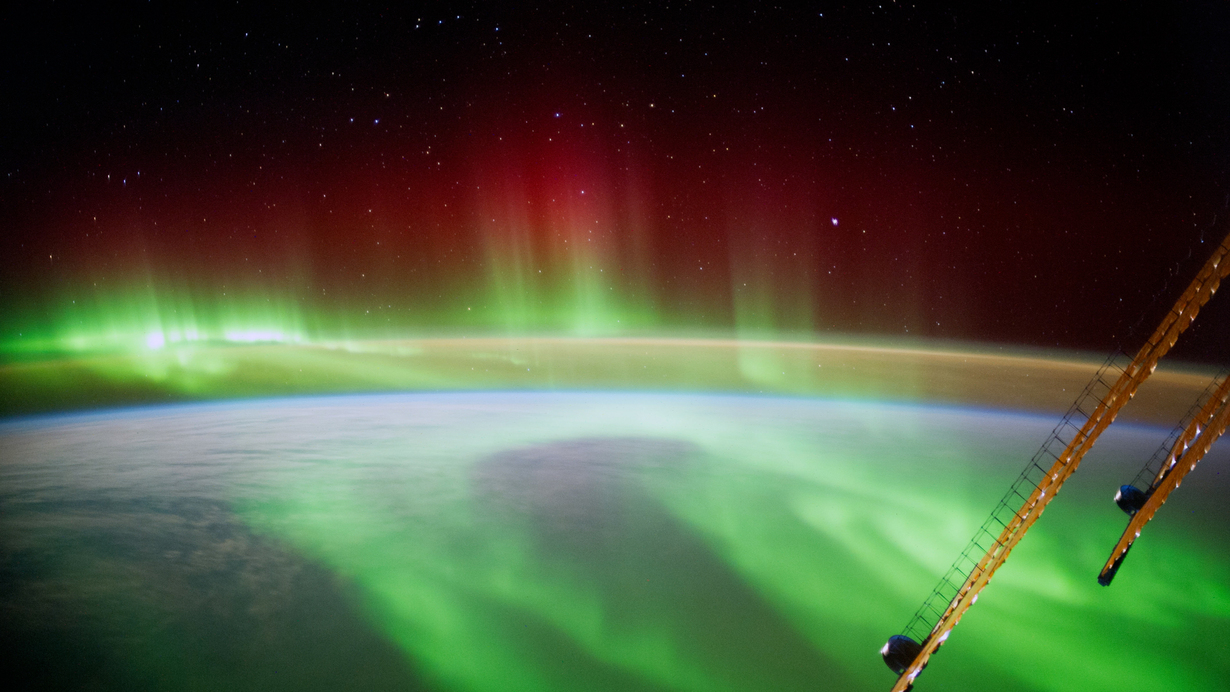

Weitere Informationen
↵Die Gruppe:
Unser Forschungsgebiet kurz erklärt; Mitarbeitende; Projekte; Veröffentlichungen , Themen für Master-und Bachelorarbeiten.
Modelle:
ICON-ART, EMAC, KASIMA und ExoTIC
Satellitendaten:
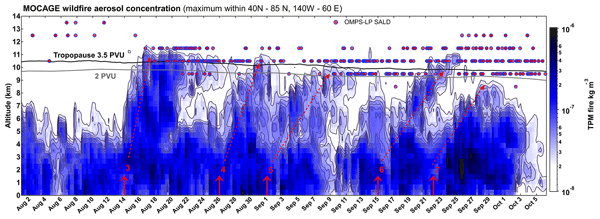
The frequency of wildfires increase due to global warming, but wildfires can also impact climate when aerosols are emitted high up into the atmosphere. An international team of authors including members of our Institute has shown that there are two pathways for these stratospheric intrusions; both were active during the exceptionally vigorous 2023 Canadian wildfires.
To the publications
The 10th HEPPA-SOLARIS meeting will be hosted by Annika Seppälä at the University of Otago, New Zealand, on January 11-15, 2027.
To SolarisHeppa website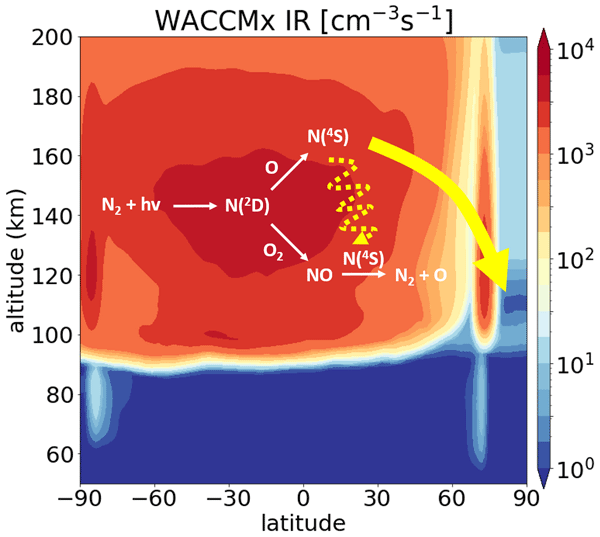
Thermospheric NO models have been shown to differ greatly in the past - we show that NO in the thermosphere is driven by an interplay between chemistry and large-scale dynamics which makes accurate representation in models of moderate spatial resolution challenging.
To the publication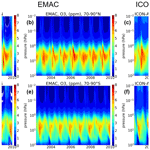 Top-down solar forcing for chemistry-climate models Top-down solar forcing for chemistry-climate modelsWe have developed a simple and cost-efficient algorithm to model top-down solar forcing by variations in the electromagnetic radiation of the sun and in the geomagnetic forcing in chemistry-climate models based on the simplified stratospheric ozone scheme LINOZ v3 in ICON-ART. To the publication |
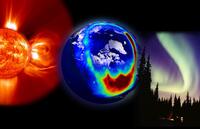 New homepage for SolarisHeppa New homepage for SolarisHeppaThe international working group solar forcing for APARC -- SolarisHeppa -- has moved to KIT. On our website, you can find the most recent information about solar forcing for CMIP7 and the ongoing evaluation experiments To SolarisHeppa website |
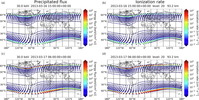 Ring current electron precipitation Ring current electron precipitationElectrons from the ring currents and radiation belts accelerated to hundreds of keV precipitate into the atmosphere during geomagnetic storms. This precipitating flux and the ensuing atmospheric ionization are modelled here with a magnetospheric model, considering different acceleration mechanism within the ring currents. To the publication |
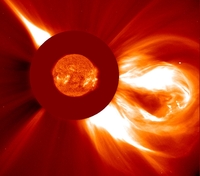 Towards improved solar forcing for chemistry-climate model experiments Towards improved solar forcing for chemistry-climate model experimentsSolar variability is part of the natural forcing of the climate system. For climate model experiments, forcing data of the spectral irradiance and particle fluxes of high precission are necessary over many decades. The forcing data provided for the Coupled Model Intercomparison Project CMIP6 were extensively used for scientific studies and tested in intercomparison experiments; here, a roadmap is discussed for an improved forcing data-set for the upcoming CMIP7. To the publication |
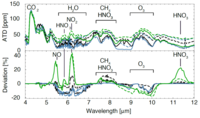 What impact does stellar activity have on observable spectral features of Earth-like exoplanets? What impact does stellar activity have on observable spectral features of Earth-like exoplanets?M-stars like Trappist can be much more active than the sun. But how does that affect possible atmospheres of planets in orbit around such starts? And, will that have an impact on the detectability of biosignatures like ozone? This is explored in a recent publications exemplarily for the exoplanet Trappist 1e. Draft of the paper on arxiv: |
 Large solar particle events and the impact of chlorine ion chemistry Large solar particle events and the impact of chlorine ion chemistryHow does a once-per-millenia solar storm compare to the well-known "Halloween" solar storm of October 2003, and does the anthropogenic chlorine loading of the early 20th century increase the impact on stratospheric ozone?
For a short summary, see the EGU blog here To the publication: |
 What would an extreme solar event do to the atmosphere? What would an extreme solar event do to the atmosphere?Even the largest solar proton events of the last 70 years had a relatively small impact on the atmosphere below 30 km altitude. But what would happen if a much larger solar event as occurred, e.g., in paleonucleid records in AD774/775? We investigated the impact on atmospheric composition and the change in UV radiation at the surface. To the publication: |
 Online-seminar on magnetospheric electron precipitation Online-seminar on magnetospheric electron precipitationWant to learn more about the impact of electron precipitation from the radiation belts? Watch recent online-seminar from Miriam Sinnhuber: To seminar talk |
 Exceptional electron precipitation observed by balloon Exceptional electron precipitation observed by balloonExceptionally electron precipitation was observed by a research balloon on December 14, 2009, in magnetic mid-latitudes. Trace gas observations confirm that precipitation in midlatitudes probably took place, despite low geomagnetic activity. To the publication |
 Results of Heppa III intercomparison experiment published Results of Heppa III intercomparison experiment publishedNew results from round III of the international High Energetic Particle Precipitation into the Atmosphere (HEPPA) intercomparison experiment published in JGR space physics recently, with focus on mesospheric NO formation during a geomagnetic storm in April 2010. To the publication |
